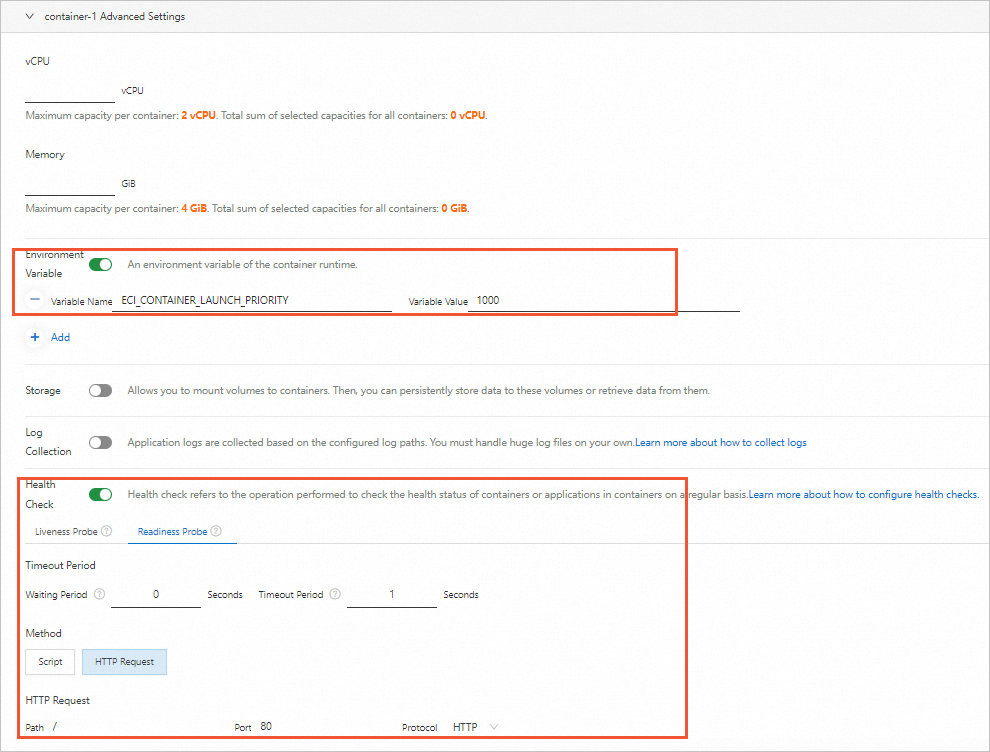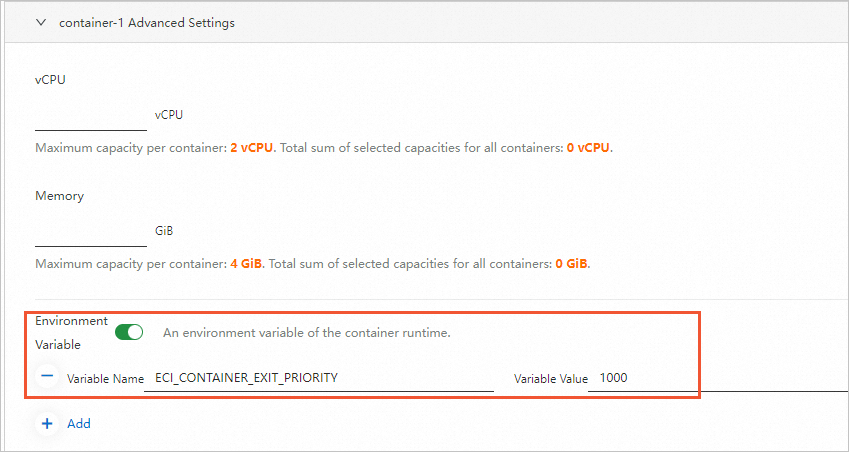This topic describes how to configure the startup and exit priorities of containers in an elastic container instance. This way, the containers start and exit in sequence.
Feature description
By default, containers in an elastic container instance concurrently start and exit. In some scenarios, containers in an instance may have a dependency relationship. A container must start after another container starts, or a container must exit after another container exits. For example:
In Istio service governance scenarios, the istio-proxy container must be ready before data transfers are generated on application containers, and the istio-proxy container can exit only after application containers exit.
In log collection scenarios, the log container must be ready before logs are generated on application containers, and the log container can exit only after application containers exit.
In the preceding scenarios, Elastic Container Instance allows you to configure the startup and exit priorities for containers in an elastic container instance by using environment variables. You can add environment variables to containers based on your business requirements to ensure that containers start or exit in sequence.
Configuration description
The following table describes the environment variables that can be used to configure the startup and exit priorities of containers:
Item | Name of the environment variable | Description |
Container startup priority | ECI_CONTAINER_LAUNCH_PRIORITY |
|
Container exit priority | ECI_CONTAINER_EXIT_PRIORITY |
|
If you call an API operation to create an elastic container instance, you can set the TerminationGracePeriodSeconds parameter to ensure that the instance exits gracefully. If you configure the sequence in which containers exit, the duration in which the instance is destroyed may be longer than the duration that is specified in TerminationGracePeriodSeconds.
Configuration examples
Configure the startup priorities of containers
API mode
Create an elastic container instance for which you configure the container startup priorities.
The following example shows the parameters that are used if you call the CreateContainerGroup API operation to create an elastic container instance. The instance contains two containers. The c1 container has a higher startup priority than the c2 container, and the c1 container is configured with a readiness probe. In this case, the c2 container starts only after the c1 container is ready.
{ "RegionId": "cn-beijing", "SecurityGroupId": "sg-2ze63v3jtm8e6syi****", "VSwitchId": "vsw-2ze94pjtfuj9vaymf****", "ContainerGroupName": "test-launch", "Container": [ { "Name": "c1", "Image": "registry.cn-shanghai.aliyuncs.com/eci_open/nginx:alpine", "EnvironmentVar": [ { "Key": "ECI_CONTAINER_LAUNCH_PRIORITY", "Value": "1000" } ], "ReadinessProbe.PeriodSeconds": 3, "ReadinessProbe.HttpGet.Path": "/", "ReadinessProbe.HttpGet.Port": 80 }, { "Name": "c2", "Image": "registry.cn-shanghai.aliyuncs.com/eci_open/nginx:alpine", "EnvironmentVar": [ { "Key": "ECI_CONTAINER_LAUNCH_PRIORITY", "Value": "0" } ], "Arg": [ "/bin/sh", "-c", "sleep 3600s" ] } ] }View the instance details and check the startup time of each container.
Call the DescribeContainerGroups API operation to query instance details. View the details of each container in the
Containerssection of the response. TheCurrentState.StartTimeparameter shows that the startup time of the c2 container is later than the startup time of the c1 container.
Console mode
When you create an elastic container instance in the Elastic Container Instance console, you can configure an environment variable in the Advanced Settings section of each container to set the startup priority of the container. You can also set a readiness probe for the container by turning on Health Check and clicking the Readiness Probe tab.

After the instance is created, you can view the events of the instance to verify the startup sequence of the containers.
Configure the exit priorities of containers
API mode
Create an elastic container instance for which you configure the container exit priorities.
The following example shows the parameters that are used if you call the CreateContainerGroup API operation to create an elastic container instance. The TerminationGracePeriodSeconds parameter is set to 30s. The instance contains the c1, c2, and c3 containers, which have descending exit priorities.
{ "RegionId": "cn-beijing", "ContainerGroupName": "test-exit", "SecurityGroupId": "sg-2ze63v3jtm8e6syi****", "VSwitchId": "vsw-2ze94pjtfuj9vaymf****", "TerminationGracePeriodSeconds": 30, "Container": [ { "Name": "c1", "Image": "registry.cn-shanghai.aliyuncs.com/eci_open/nginx:alpine", "EnvironmentVar": [ { "Key": "ECI_CONTAINER_EXIT_PRIORITY", "Value": "1000" } ] }, { "Name": "c2", "Image": "registry.cn-shanghai.aliyuncs.com/eci_open/nginx:alpine", "EnvironmentVar": [ { "Key": "ECI_CONTAINER_EXIT_PRIORITY", "Value": "0" } ], "Arg": [ "/bin/sh", "-c", "sleep 3600s" ] }, { "Name": "c3", "Image": "registry.cn-shanghai.aliyuncs.com/eci_open/nginx:alpine", "EnvironmentVar": [ { "Key": "ECI_CONTAINER_EXIT_PRIORITY", "Value": "-1000" } ], "Arg": [ "/bin/sh", "-c", "sleep 3600s" ] } ] }Delete the instance and then observe the killing event sequence of the containers in the instance.
NoteIf you want to check the sequence in which the containers exit, view the events in a timely manner. You may not be able to observe the events after the elastic container instance is deleted.
Call the DescribeContainerGroupEvents API operation to query instance events. View the killing event time of each container in the
Eventssection of the response. The c1, c2, and c3 containers exit in sequence.
Console mode
When you create an elastic container instance in the Elastic Container Instance console, you can configure an environment variable in the Advanced Settings section of each container to set the exit priority for the container.
